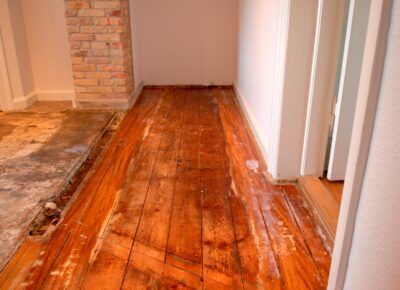As hurricane season continues to cause heavy home damage throughout the southeastern states, many homeowners are replacing flood damaged flooring. To do this, you’ll have to go through multiple steps, and it’s important that your new flooring is durable and safe.
Six Main Steps For Replacing Flood Damaged Flooring
The following instructions below are a basic guide for replacing flood damaged flooring.
1) Assess the damage. Depending on the flooring type, you should be checking for warping, mold, or lingering water damage. If your flooring is tile, repairs may do the trick, but with hardwood, laminate and carpet, you’ll probably need complete removal.
Be sure to inspect the subfloor as well, and check for weakening or warping. You may need to replace portions of the subfloor too.
2) Remove damaged flooring. Take the time to carefully remove damaged flooring, using the appropriate tools. Ensure that you’re disposing of the flooring materials in an environmentally responsible way, especially if you have mold damage.
3) Dry the area thoroughly. Open your windows, and use fans and dehumidifiers to fully ventilate and dry out the subfloor. You can use moisture meters to ensure a floor is dry before proceeding.
You may also need to apply a mold-inhibiting solution to affected areas to prevent mold from developing under your new flooring.
4) Repair or replace the subfloor if necessary. If you find that portions of the subfloor need replacing, just replace those sections to save on your costs. If the area is prone to moisture, it’s a good idea to apply a waterproofing sealant or barrier to the subfloor.
5) Install your new flooring. If you live in a flood-prone area, your new flooring should be made from tile, vinyl, or waterproof laminate. This is a better option for durable flooring than hardwood or carpet.
When installing your new flooring, follow the manufacturer’s instructions carefully, or reach out to a professional with solid experience in replacing flood damaged flooring. Make sure there are proper gaps for expansion, and that your new flooring follows moisture guidelines.
6) Perform a final inspection. Check to ensure that your new flooring is level and secure. Be sure to maintain your new floor regularly, and use dehumidifiers or moisture barriers to protect the new flooring for the future.
Do You Have Damaged Flooring?
Replacing flood damaged flooring can be done by homeowners, but it’s best to leave the task to trusted professionals in your region. If you have damaged floors you need replaced and you live in the upstate South Carolina area, contact Upstate Flooring Direct. We can help replace your flooring, and help you recover from the flooding. Click here to reach out to us today.
See more flooring advice, useful tips, and customer testimonials on our Facebook page.

